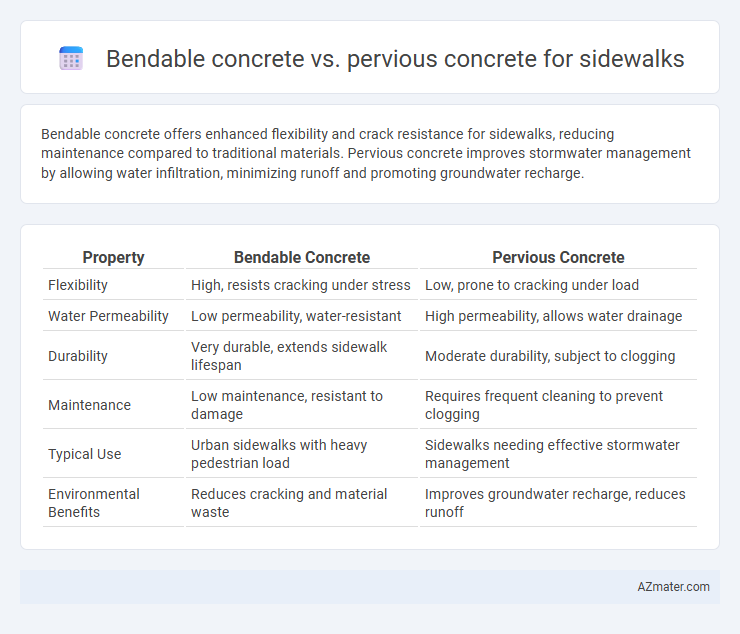Bendable concrete offers enhanced flexibility and crack resistance for sidewalks, reducing maintenance compared to traditional materials. Pervious concrete improves stormwater management by allowing water infiltration, minimizing runoff and promoting groundwater recharge.
Table of Comparison
| Property | Bendable Concrete | Pervious Concrete |
|---|---|---|
| Flexibility | High, resists cracking under stress | Low, prone to cracking under load |
| Water Permeability | Low permeability, water-resistant | High permeability, allows water drainage |
| Durability | Very durable, extends sidewalk lifespan | Moderate durability, subject to clogging |
| Maintenance | Low maintenance, resistant to damage | Requires frequent cleaning to prevent clogging |
| Typical Use | Urban sidewalks with heavy pedestrian load | Sidewalks needing effective stormwater management |
| Environmental Benefits | Reduces cracking and material waste | Improves groundwater recharge, reduces runoff |
Introduction to Bendable and Pervious Concrete
Bendable concrete, also known as strain-hardening cementitious composite (SHCC), features enhanced flexibility and crack resistance, making it ideal for sidewalks subjected to dynamic loads and potential ground movement. Pervious concrete is designed with high porosity to allow water infiltration, reducing runoff and promoting groundwater recharge while maintaining sufficient structural integrity for pedestrian use. Both materials address common sidewalk challenges but serve different functional purposes: bendable concrete improves durability against deformation, whereas pervious concrete supports effective stormwater management.
Key Material Properties Compared
Bendable concrete offers enhanced tensile strength and flexibility due to fiber reinforcement, reducing cracking in sidewalks subjected to heavy loads and ground movement. Pervious concrete features high porosity and permeability, allowing water infiltration to reduce surface runoff and improve stormwater management but has lower compressive strength compared to bendable concrete. Selecting between them depends on balancing durability and load resistance with environmental water drainage needs for sidewalk applications.
Flexibility and Crack Resistance
Bendable concrete offers superior flexibility and crack resistance compared to pervious concrete, making it ideal for sidewalks subjected to soil movement and temperature fluctuations. Its engineered fiber reinforcement enables it to bend and absorb stresses without fracturing, extending the pavement lifespan significantly. Pervious concrete, while beneficial for drainage and reducing runoff, is more prone to cracking under stress due to its porous structure and lower tensile strength.
Water Permeability and Drainage Capabilities
Bendable concrete offers moderate water permeability, helping reduce minor surface water accumulation but primarily excels in flexibility and crack resistance for sidewalks. Pervious concrete significantly outperforms in water permeability and drainage capabilities, allowing rapid infiltration of stormwater through its porous structure to reduce runoff and promote groundwater recharge. Selecting pervious concrete enhances sidewalk drainage efficiency in areas prone to heavy rainfall, while bendable concrete provides durability with limited water permeability.
Strength and Durability Analysis
Bendable concrete exhibits superior tensile strength and flexibility compared to pervious concrete, effectively resisting cracking under heavy pedestrian loads and thermal expansion on sidewalks. Pervious concrete offers high permeability for efficient stormwater drainage but has lower compressive strength and durability, making it more susceptible to wear and freeze-thaw damage in high-traffic areas. For long-lasting sidewalk applications requiring load resilience, bendable concrete provides enhanced durability and structural integrity over pervious concrete.
Environmental Impact and Sustainability
Bendable concrete enhances environmental sustainability by reducing cracking and extending sidewalk lifespan, which lowers the demand for frequent repairs and material consumption. Pervious concrete supports sustainable urban drainage by allowing stormwater infiltration, reducing runoff pollution and mitigating flooding. Both materials contribute to eco-friendly sidewalks, with bendable concrete focusing on durability and pervious concrete prioritizing water management.
Installation Methods and Costs
Bendable concrete for sidewalks requires specialized reinforcement and flexible admixtures during installation, increasing labor complexity and material expenses compared to traditional mixes. Pervious concrete installation involves careful layering and compaction to maintain porosity, generally resulting in lower labor costs but requiring meticulous site preparation to ensure proper drainage. While bendable concrete typically costs 20-30% more due to advanced materials and skilled labor, pervious concrete remains cost-effective but may incur additional expenses for subbase preparation to prevent clogging and maintain permeability.
Maintenance Requirements for Sidewalks
Bendable concrete requires less frequent maintenance for sidewalks due to its enhanced flexibility and resistance to cracking under stress, minimizing repair costs and disruptions. Pervious concrete, while excellent for drainage and reducing runoff, demands regular cleaning to prevent clogging and maintain permeability, which can increase upkeep efforts. Choosing bendable concrete can lead to lower long-term maintenance needs, whereas pervious concrete's environmental benefits come with a trade-off in maintenance frequency.
Best Applications and Use Cases
Bendable concrete offers superior flexibility and crack resistance, making it ideal for sidewalks in areas prone to ground movement or heavy foot traffic, ensuring long-lasting durability. Pervious concrete excels in stormwater management by allowing water infiltration, making it the best choice for sidewalks in urban areas with frequent rainfall or drainage concerns. Both materials optimize functionality, with bendable concrete prioritizing structural resilience and pervious concrete enhancing environmental sustainability.
Conclusion: Choosing the Right Concrete for Sidewalks
Bendable concrete offers superior crack resistance and flexibility, making it ideal for sidewalks exposed to heavy loads and ground movement. Pervious concrete excels in stormwater management by allowing water infiltration, reducing runoff and improving drainage in urban areas. Selecting the right concrete depends on prioritizing structural durability with bendable concrete or environmental benefits and water permeability with pervious concrete for sidewalk applications.

Infographic: Bendable concrete vs Pervious concrete for Sidewalk
 azmater.com
azmater.com